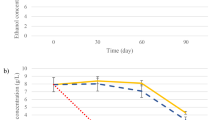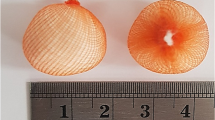Summary
Yeast cells were immobilized by adhesion to cotton cloth using polyethylenimine. Yeast cells could be adhered to cotton cloth by coating either the yeast cells or cotton cloth or both with polyethylenimine. Adhered cells were not desorbed by washing with 1 M KCl or 50% (v/v) ethylene glycol or 0.1 M buffers pH 3.6–8.0. Also presence of salt (1 M) in the cell suspension was not found to alter the binding capacity of the cells. The yeast cell bound cloth was used in a specially designed frame reactor (2.3 L) for the repeated inversion of sucrose in 16 batches over a period of 3 weeks still retaining about 80% of the original invertase activity.
Similar content being viewed by others
References
Bar R, Gainer JL, Kirwan DJ (1986) Immobilization ofAcetobacter aceti on cellulose ion exchangers: Adsorption isotherms. Biotechnol Bioeng 28:1166–1171
Bringi V, Dale BE (1985) Enhanced yeast immobilization by nutrient starvation. Biotechnol Letters 7:905–908
D'Souza SF, Nadkarni GB (1980) Continuous inversion of sucrose by gel entrapped yeast cells. Enzyme Microb Technol 2:217–222
D'Souza SF, Melo JS, Deshapande A, Nadkarni GB (1986) Immobilization of yeast cells by adhesion to glass surface using polyethylenimine. Biotechnol Lett 8:643–648
Juneja LR, Terasawa M, Yamane T, Shimizu S (1986) Continuous ethanol fermentation using flocculent yeast entrapped in horizontal parallel flow bioractor system. Biotechnol Lett 8:431–436
Marshall RC (ed) (1984) Microbial adhesion and aggregation. Springer Verlag, New York
Mattiason B (1983) Immobilized cells and cellular organelles, Vol. 1–2, Mattiason (ed), CRC-Press, Boca Raton, Florida
Miller GL (1959) Use of dinitrosalicylic acid reagent for determination of reducing sugar. Anal Chem 3:426–428
Mozes N, Marchal F, Hermesse MP, Van Haecht JL, Reuliaux L, Leonard AR, Rouxhet PG (1987) Immobilization of microorganisms by adhesion: Interplay of electrostatic and non-electrostatic interactions. Biotechnol Bioeng 30:439–450
van Haecht JL, Bolipombo M, Rouxhet PG (1985) Immobilization of Saccharomyces cerevisiae by adhesion: Treatment of the cells by Al ions. Biotechnol Bioeng 27:217–224
Yoshioka T, Shimamura M (1986) Studies on polystyrene-based-ion-exchange fiber. V. Immobilization of microorganism cells by adorption on a novel fiber-form anion exchanger. Chem Soc Japan 59:77–81
Author information
Authors and Affiliations
Rights and permissions
About this article
Cite this article
D'Souza, S.F., Kamath, N. Cloth bioreactor containing yeast cells immobilized on cotton cloth using polythylenimine. Appl Microbiol Biotechnol 29, 136–140 (1988). https://doi.org/10.1007/BF00939297
Received:
Accepted:
Issue Date:
DOI: https://doi.org/10.1007/BF00939297




